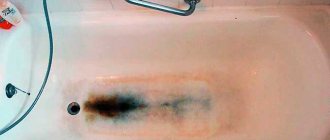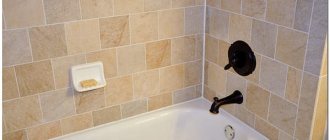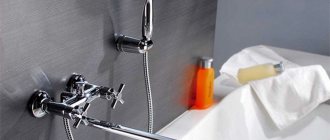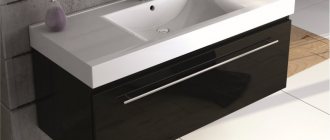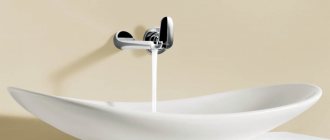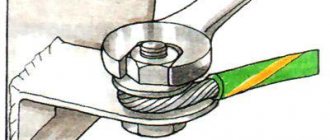Installing a decorative screen covering the space under the bathtub is the final stage of renovation of the room. There are many options for solving this problem: from hanging curtains to complex podium structures. Before closing the bathtub from below, you need to choose the optimal solution that will help you make good use of the space under the bowl.
Ready-made screens for finishing
A budget option is to install an industrial screen. It is most often used for finishing due to its ease of installation and large selection of design options.
The screens have standard sizes corresponding to the size of the bowl. They are made of plastic, metal, glass or wood. Finished products are a frame made of aluminum or plastic profile in which decorative panels are placed.
Depending on the design they are:
- deaf;
- with sliding or hinged doors;
- with drawers.
Screens are installed independently. To do this, the canvas is placed under the side of the bathtub, installed vertically and secured with screw-out support legs. Due to the fact that no other fastening elements are used, the screens can be easily dismantled for access to communications.
Blind structures
They are a panel that completely covers the space under the plumbing fixture.
The design is easy to install, but has a significant drawback - irrational use of free space.
It is inconvenient to store household items under the bathtub: to get them out, you will have to dismantle the entire structure. Therefore, closing the space under the bowl is not a very good solution to the use of space.
Sliding screens
The most commonly used option.
The device doors do not take up additional space when opened. The panels move along guides and overlap each other. Most often, screens with two or three doors are used, less often with four.
The more panels that can be moved, the wider the niche, which during repairs makes it easier to access communications without dismantling the screen.
Unlike solid structures, sliding screens require maintenance and periodic cleaning of the guide grooves.
Screens with storage drawers
The most convenient option for storing things under the bathroom.
The fittings used ensure smooth movement of the drawers. Items located in them are protected from mold.
Installing such a screen yourself will often cause difficulties. The use of this design in apartments is difficult due to the small area of the room. To provide access to pipelines, it is necessary to completely dismantle the structure, so this screen is more suitable for large rooms.
Stationary options
To install the main screen, the following materials are used:
- brick;
- Fiberboard or OSB;
- moisture-resistant drywall or plywood;
- tree.
The aesthetic appearance of the structure is given with the help of finishing materials. Ceramic tiles or mosaics are most often used. An inspection hole is left at the location of the bathtub drainage device and sewer pipe connections and covered with an easily removable panel. In this case, storing things under the bowl is excluded.
Decorative curtain
Using a curtain, you can securely close the basement space with your own hands. This method is rightfully considered the most accessible, simple and cheap. It perfectly hides imperfections under the bathroom, disguises unattractive places, and, in addition, makes it possible to safely store all the necessary cleaning products and equipment.
Decorative curtain
The curtain is easy to care for, i.e. she is unpretentious in everyday life. It is enough to pick up an ordinary piece of cloth and wipe it periodically. In addition, the fabric can be useful for placing the curtains around the perimeter and fastening them together. This will compact the material, making it more durable and practical. Usually special folds are left, but you can do without them.
The product can be secured in various ways, for example, by making fastenings using a special Velcro tape, and it is important that it is double-sided. Thus, one side is attached to the panel itself, and the other is secured under the rim of the bathtub using liquid nails. In addition, a small diameter furniture pipe can be used to fasten the structure. It must have the necessary fastenings in the form of loops, for which the coupling will be carried out.
Worth knowing! When choosing a screen, you should take into account the overall design of the apartment, for example, for a rustic style, a light curtain is suitable, and for a high-tech, a metal screen will be the best option.
How to work with a finished screen
Factory-made panels are equipped with fittings, fasteners and frames as needed.
If the dimensions of the structure correspond to the dimensions of the bathtub, then installation will not cause any difficulties.
To work you will need:
- screwdriver;
- roulette;
- building level or plumb line.
Before installing the screen, the bowl must be filled with water.
The installation steps do not depend on the shape and design of the product and are performed in the following sequence:
- Measurements and markings. They are carried out to determine the installation locations of fasteners for fixing the frame. If necessary, panels are adjusted to the required dimensions.
- Frame installation. Carry out in accordance with the instructions using a building level. If the product has moving elements, then guides are additionally attached.
- Adjustment of support legs. By twisting them, they achieve maximum support of the frame against the side of the bowl. To prevent the supports from moving, the legs are fixed with sealant.
- Fastening the upper part of the frame. The junction of the frame and the bathtub canopy must be blown with foam to impart rigidity to the structure.
- Installation of panels. The blades of sliding devices are installed in the grooves of the guides, while those of hinged devices are hung on hinges. The fittings are screwed onto the doors.
- Sealing of seams. The joints must be sealed with sealant or any other available method to prevent water from getting under the bathtub.
Installing a plastic model will require the installation of additional supports to give the product rigidity.
Podium
Of course, curtains are good, however, there are other options. Podiums are suitable for a spacious shower room, where there is room to turn around. The finishing, design, and dimensions of this structure can be very diverse, and their limitations are limited only by the customer’s imagination. A brick is laid at the base of the frame, after which the panel is decorated with tiles or mosaics. The main thing is that all steps are treated with an anti-slip compound.
Podium under the bath
Making your own screen
When making your own screen, you need to take into account the increased humidity and temperature changes in the bathroom to select the right material.
The easiest way is to build a stationary structure, but in this case access to the entire space under the bathroom will be limited.
You can borrow ideas from the Internet, where there are many photos of furnished rooms with any placement of the bowl.
Material selection
The material is selected depending on the design of the selected screen.
It can be made from:
- PVC or MDF boards;
- Chipboard or OSB;
- bricks;
- drywall or plywood;
- glass;
- tree.
The optimal material for a structure with sliding panels is plastic, and for a blank screen - moisture-resistant plasterboard. In the first case, no additional finishing is required, but in the second, facing materials must be used.
Required Tools
To carry out the work you need tools such as:
- drill, grinder, screwdriver;
- building level, tape measure;
- stapler, mounting knife;
- hammer.
The frame can be made either from a profile or from wooden slats. The latter must be treated with an antiseptic to prevent rotting.
Process step by step
Before starting work, it is necessary to take measurements and draw up a design drawing taking into account the existing skirting boards, boxes and other protruding parts falling into the installation area.
A simple and reliable option would be to make a frameless screen from PVC panels. If the bathtub is located from wall to wall, then the task is simplified. In this case, there is no need to seal the side of the bowl.
The sequence of manufacturing and installation of the structure is as follows:
- Cut PVC panels and starting strips according to existing sizes. Mark a line on the floor for installing the screen.
- Assemble plastic panels on guides into a single structure.
- Install vertical and horizontal starting strips on the finished canvas.
- Apply assembly adhesive along the line in a continuous strip on the floor. On the top and side profiles, the adhesive composition is applied pointwise.
- Place the finished panel in place. Press the top starting bar against the front side of the bowl.
If it is necessary to dismantle the structure, the lining strips must be removed from the starting profiles, bending them in the middle. If during disassembly some elements are damaged, they are replaced with new ones.
Other options
In addition to screens of various designs, the space under the bathroom can be closed:
- ceramic tiles;
- podium;
- decorative curtain.
The bathroom looks much better if sewer lines and objects located under the bowl are not visible.
Tile finish
To cover the screen with tiles, you need to prepare the base.
To make it you will need brick or waterproof plasterboard. Many people prefer the second option.
Making a plasterboard base is easier and faster than laying a brick wall. Mount the material on a frame made of metal profile. The side and bottom horizontal strips are fixed with dowels.
Vertical racks are installed in increments of 50-60 cm. In the place where the inspection hatch will be, a kind of frame is made from the profiles, the dimensions of which correspond to the dimensions of the decorative grille.
Pieces of drywall are screwed with self-tapping screws. The finished structure is treated with a primer to increase the adhesion of the material. The tiles are laid on an adhesive mixture such as Ceresit.
To reduce the weight of the structure, you can use dispersion or polymer glue. Its main advantage is water resistance.
Laying begins from the most visible corner with a whole tile. It is better to use the material with which the walls are lined. Then the structure will be perceived as a single whole. You can cover the screen with mosaics. The rules for its installation are similar.
Bath podium
This design can be built in a large room
There are many options for arranging a podium. Here you can bring to life any ideas that are limited only by the dimensions of the structure.
The monolithic podium is made of brick or small blocks and lined with tiles, porcelain stoneware or mosaics. The steps are finished with anti-slip material.
To make frames in the form of a podium, wooden beams are used. The structure is covered with wood, which is pre-treated with a special impregnation against rot. The top of the product is varnished.
The option with a podium does not provide the possibility of servicing communications, and in the event of a breakdown, dismantling of the structure will be necessary.
